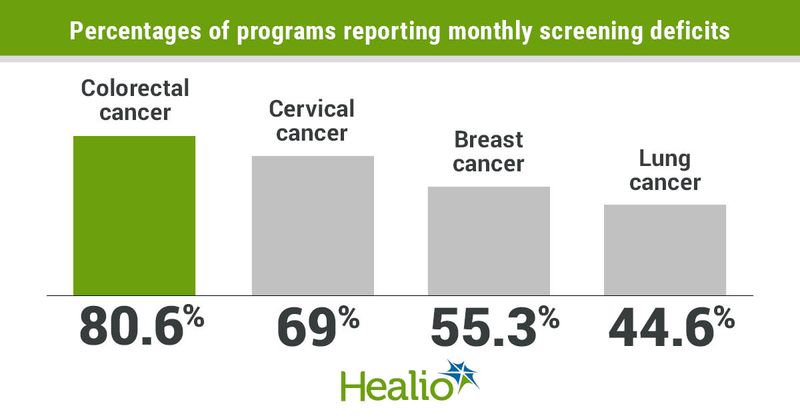Cancer programs aim to address critical gaps in screening due to pandemic
Cancer screening remains in need of urgent attention, and online resources may help facilities close gaps and address screenings missed in 2020, according to a prospective quality improvement study published in Cancer.
“Several months into the pandemic, monthly screening rates had not recovered as much as we expected, probably due to ongoing surges of COVID-19. It was very gratifying that 748 accredited Commission on Cancer and National Accreditation Programs for Breast Centers signed up in just 8 weeks to participate in this national effort to reverse the downward trends in screening,” Heidi Nelson, MD, FACS, medical director of cancer programs at the American College of Surgeons, told Healio.

Background
Cancer screening deficits associated with the COVID-19 pandemic are expected to result in an increase in cancer-related deaths over the next decade, according to Nelson and colleagues. A structured response to identifying and addressing local screening deficits had been lacking, despite details on national deficits.
Researchers sought to both share preliminary data across diverse settings on monthly screening deficits in breast, colorectal, lung and cervical cancers and provide online materials from a national quality improvement study to help other institutions address local screening deficits.

“An important publication showed that monthly rates of screenings dropped significantly with the onset of the pandemic; over 9 million people missed cancer screenings,” Nelson said. “Since cancer screening saves lives and since it is an important part of accreditation for Commission on Cancer and National Accreditation Program for Breast Centers, we decided to do our part to get people back to screening.”
Methodology
The Return-to-Screening study, initiated by American College of Surgeons Cancer Programs and American Cancer Society, included 748 accredited cancer programs (436 for breast cancer, 220 for lung cancer, 129 for colorectal cancer and 29 for cervical cancer) in the U.S. from April through June 2021.
Researchers used local pre-pandemic and pandemic monthly screening test volumes (MTVs) to calculate the relative percent change in MTV to describe the monthly screening gap.
Key findings
Results showed most facilities reported monthly screening deficits, including 80.6% of colorectal cancer, 69% of cervical cancer, 55.3% of breast cancer and 44.6% of lung cancer programs. Additionally, the median relative percent change in MTV ranged from 17.7% for colorectal cancer (interquartile range [IQR], 33.6 to 2.8) to 6.8% for cervical cancer (IQR, 29.4 to 1.7), 1.6% for breast cancer (IQR, 9.6 to 7) and 1.2% for lung cancer (IQR, 16.9 to 19).
Nelson and colleagues observed no geographic differences but did report statistically significant differences in the percent change in MTV between institution types for colorectal cancer screening (P = .02).
“Colorectal screening was the most impacted, and we speculate that this was due to the invasive nature of the procedure and perhaps due to apprehensions regarding risk [for] COVID exposure,” Nelson said.
Implications
Nelson said the researchers hope the study raises awareness about the ongoing gaps in cancer screening. They also provided the study’s Return-to-Screening Plan-Do-Study-Act protocol and information about the evidence-based interventions from American Cancer Society, so hospitals outside of the Commission on Cancer and the National Accreditation Program for Breast Centers can use this material to help reverse the worrisome trends of patients missing screenings, Nelson said.
The cancer programs enrolled in the study used the results to initiate 814 local quality improvement projects in colorectal, breast, lung and cervical cancer screening. These had the potential to add 57,141 monthly screening tests for breast cancer, 6,079 for colorectal cancer, 4,280 for cervical cancer and 1,744 for lung cancer by the end of last year, screening rates for which are still being assessed.
“The major response we generated to this urgent situation brought this possibility to our attention: leveraging our same cancer quality programs to help identify which interventions are the most effective at helping people get cancer screening,” Nelson said. “We know that not all people participate in screening and perhaps we can learn from this experience what works best.”
References:
Joung RH, et al. Cancer. 2022;doi:10.1002/cncr.34157.
Study identifies and addresses US cancer screening deficits due to the COVID-19 pandemic. Available at: https://newsroom.wiley.com/press-releases/press-release-details/2022/Study-identifies-and-addresses-US-cancer-screening-deficits-due-to-the-COVID-19-pandemic/default.aspx. Published March 21, 2022. Accessed March 21, 2022.
For more information:
Heidi Nelson, MD, FACS, can be reached at Cancer Programs, American College of Surgeons, 633 N. Saint Clair St., Chicago, IL 60611-3295; email: hnelson@facs.org.
